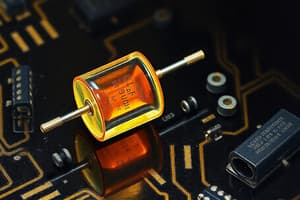Podcast
Questions and Answers
What is the main function of rectifier diodes?
What is the main function of rectifier diodes?
- Emitting light when an electric current passes through
- Stabilizing and regulating voltage
- Converting alternating current (AC) to direct current (DC) (correct)
- Generating renewable energy
What distinguishes Schottky diodes from silicon rectifier diodes?
What distinguishes Schottky diodes from silicon rectifier diodes?
- Lower current capacity and higher forward voltage drops
- Higher current capacity and lower forward voltage drops
- Higher forward voltage drops and slower switching times
- Lower forward voltage drops and faster switching times (correct)
What makes Zener diodes widely used in voltage stabilization and regulation circuits?
What makes Zener diodes widely used in voltage stabilization and regulation circuits?
- They convert light energy into electric energy
- They allow current flow in one direction while blocking it in the other
- They create a stable voltage that is independent of the current when the breakdown voltage is reached (correct)
- They emit light when an electric current passes through
What is the main function of photovoltaic (PV) diodes or solar cells?
What is the main function of photovoltaic (PV) diodes or solar cells?
What characteristic makes tunnel diodes suitable for applications such as microwave oscillators and voltage converters?
What characteristic makes tunnel diodes suitable for applications such as microwave oscillators and voltage converters?
What type of semiconductor materials are semiconductor diodes typically made from?
What type of semiconductor materials are semiconductor diodes typically made from?
How do semiconductor diodes control the flow of electric current?
How do semiconductor diodes control the flow of electric current?
What causes the generation of a depletion region in a semiconductor diode?
What causes the generation of a depletion region in a semiconductor diode?
What is the approximate built-in voltage for a silicon diode?
What is the approximate built-in voltage for a silicon diode?
Which type of diode is used for converting light energy into electric energy?
Which type of diode is used for converting light energy into electric energy?
Study Notes
Introduction to Semiconductor Diodes
A diode, specifically a semiconductor diode, is a fundamental electronic component that plays a crucial role in the functioning of various electronic systems. These miniature devices control the flow of electric current, enabling components to communicate effectively and perform desired tasks. Semiconductor diodes are made from silicon, germanium, or other semiconducting materials, and they operate based on the principles of P-N junction, which are formed by combining a p-type semiconductor (with excess positive charge) and an n-type semiconductor (with excess negative charge).
In this article, we will delve into the fascinating world of semiconductor diodes, their importance, and their various types, including:
- P-N Junction and the Functioning of Diodes
- Rectifier Diodes
- Zener Diodes
- Light Emitting Diodes (LEDs)
- Photovoltaic Diodes
- Laser Diodes
- Tunnel Diodes
P-N Junction and the Functioning of Diodes
A P-N junction is formed when a p-type semiconductor (p-doped) and an n-type semiconductor (n-doped) are placed in contact with each other. When the two semiconductor layers meet, they create an energy gradient, causing electrons to move from the n-type material to the p-type material. This movement generates a depletion region, characterized by a high resistance, and a built-in voltage (approximately 0.6 V for a silicon diode).
Diodes control current flow by allowing it to pass in one direction (forward current) while blocking it in the other (reverse current). Forward current occurs when the built-in voltage is overcome by an external voltage applied to the diode, while reverse current flow is suppressed due to the high resistance of the depletion region.
Rectifier Diodes
Rectifier diodes are fundamental electronic components that enable the conversion of alternating current (AC) to direct current (DC). They are essential in the functioning of power supplies, audio amplifiers, and circuits that need to operate on DC power. They can be of various types, including:
- Silicon rectifier diodes: These are the most common and least expensive rectifiers, offering high current capacity and low forward voltage drops.
- Schottky diodes: These have lower forward voltage drops and faster switching times than silicon rectifiers, making them suitable for high-frequency applications.
Zener Diodes
Zener diodes are semiconductor diodes with a specific breakdown voltage (usually between 1 and 100 volts). When the voltage across a Zener diode reaches the breakdown voltage, current flows through the diode, creating a stable voltage that is independent of the current. Zener diodes are widely used in voltage stabilization and regulation circuits.
Light Emitting Diodes (LEDs)
LEDs are semiconductor diodes that emit light when an electric current passes through them. LEDs are a highly energy-efficient and environmentally friendly source of light, making them a popular choice for applications such as lighting, displays, and signage.
Photovoltaic Diodes
Photovoltaic (PV) diodes, also known as solar cells, are semiconductor diodes that convert light energy into electric energy. They are a fundamental component of solar panels, enabling the generation of clean, renewable energy.
Laser Diodes
Laser diodes are semiconductor diodes that emit light through a process known as stimulated emission. They are highly versatile components, employed in applications such as laser pointers, barcode scanners, and optical data storage systems.
Tunnel Diodes
Tunnel diodes are semiconductor diodes that operate based on a quantum mechanical phenomenon called the tunneling effect. They can have a negative resistance characteristic, enabling them to oscillate at high frequencies, making them suitable for applications such as microwave oscillators and voltage converters.
In summary, semiconductor diodes are an essential component of electronics, and they operate based on the principles of P-N junctions. Understanding the various types of diodes and their applications is crucial for designing and implementing electronic systems.
Studying That Suits You
Use AI to generate personalized quizzes and flashcards to suit your learning preferences.
Description
Explore the world of semiconductor diodes and their various types such as rectifier diodes, Zener diodes, LEDs, photovoltaic diodes, laser diodes, and tunnel diodes. Learn about the functioning of semiconductor diodes and their significance in electronic systems.




